Wi-Fi Coverage for a Larger Home: Using “Extenders,” “Mesh,” and “Campus” Systems
Introduction
Almost any router will provide Wi-Fi throughout a small or medium-sized home, and LCWA’s current router recommendation, the Ubiquiti airCube, will be just fine for you.
But if your house is large, or oddly shaped, or has thick interior walls—and especially if it includes separate outbuildings—then such coverage may be limited, and you may need to find ways to extend your Wi-Fi coverage.
Don’t Get a Big Router
What you should not do is buy one of those expensive, high-speed, high-power routers with big antennas and lofty claims. These can cost over $200 and they look impressive. The problem is they achieve their results by using the 5Ghz radio, which conflicts with your LCWA rooftop radio and so can actually slow things down.
The Right Solutions
If you’ve got a reasonably good router, then short of installing Ethernet wiring in your walls (or along with it), the right solution is different. You may want to consider adding components like extenders, mesh systems, or campus Wi-Fi systems to your existing router—one of these approaches could be your solution. But which should you use that will be compatible with the LCWA network? Not all extenders, mesh, and campus systems will play well with our radio network, so read this article before you buy
Note: Normally LCWA volunteers do not get involved
LCWA volunteers normally don’t get involved in installing these systems for you. In our install we deliver internet to one point in the house, and that’s it. But we do want you to succeed if you go this route. To that end, we’ve studied the choices that can work well with the LCWA network, and we’ll give you a few written tips like this article. And we’ll lead you to paid help if you need it.
We’ll start with the least expensive solutions and work our way up.
Wi-Fi Extenders: The $15 solution
The least expensive and simplest solution to solving Wi-Fi coverage issues in your house is to get a wireless Wi-Fi extender and put it near the other side of the house. Inexpensive ones are often the best since they don’t have interfering 5Ghz radios built in, and they can work fairly well.
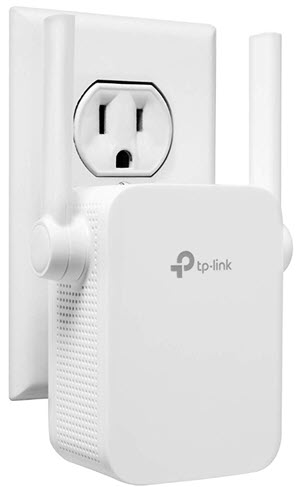
TP-Link N300 Range Extender, about $15
Pros:
- Inexpensive, starting at less than $15.
- No wiring needed.
Cons: extenders are not the best solution because they have many issues and limitations:
- One issue is this: You will sacrifice speed even though they can display a strong Wi-Fi signal on your device. Even with that strong displayed signal, they routinely deliver as little as half the speed of your main router Wi-Fi. So, if Wi-Fi speed is an issue to you, don’t use them. And if you do use them, don’t hook your smart TV or other HD-movie-streaming devices to the extender; those high-consumption devices will suffer.
- Another problem with extenders is that they essentially create a separately named Wi-Fi network. The result? You can lose roaming convenience on your cellphone or laptop around the house since you’ll likely need to manually switch Wi-Fi sources on your cellphone or laptop as you move.
- Be careful when buying: if you get one with a 5 Ghz radio, it will interfere; stick with 2.4 Ghz models like the one we show below.
- Extenders are somewhat tricky to set up—they are not plug and play and can be confusing to configure.
- Related to such set up, power outages can fully clear the extender’s connection to the base router, and you might need to start from scratch to reactivate them.
- Extenders don’t work well for very large houses because they need to be placed moderately close to the main router. You’ll likely still be left with dead zones.
All that said, there are tons of low-cost extenders on the market that can work (note higher cost extenders usually have 5Ghz radios and are not recommended).
Recommended Extender Model: TP-Link N300 Range Extender
Shown in the image above, this extender is very inexpensive (currently less than $15 at Amazon), it is from a trusted brand, it is relatively easy to set up (using a smartphone app), and has no 5 Ghz radio to interfere with your rooftop radio. We’ve tested it and it works well.
But again, don’t expect internet speeds on devices connected to the extender to match your base router Wi-Fi speed—no extender can do that.
Adding a Wired Second Wi-Fi Access Point: the $25 to $65 Solution
Most large houses can reach full-speed coverage if you simply add one more strong Wi-Fi access point at the other end of the house from your router. To do that, a better solution than an extender is to add a wired second Wi-Fi access point. You simply plug a long Ethernet wire into your router and plug the other end into the unit.
Pros: A wired Wi-Fi access point is good because:
- It can be much further from the main router than an extender (up to 300 feet).
- No matter where it is, it is faster than an extender: since it’s wired to the router, it potentially will achieve speeds equivalent to your base router Wi-Fi point.
- Very simple to set up (other than the wiring).
Cons: Yes, there are issues.
- If you do not already have Ethernet wiring in your house walls, you will need to string new Ethernet wiring in your house, say along the floor, which may be messy, and Ethernet wires will cost you another $20 to $40.That said, there is a non-Ethernet option that can, in some cases, solve that; shown below.
- Like extenders, the Wi-Fi access point creates a separately named Wi-Fi network that you need to choose manually. So, like an extender, you can lose roaming convenience on your cellphone or laptop as you move around the house.
- Again, don’t buy one with a 5Ghz radio, it will interfere with the LCWA network. Get the one below that we recommend.
Recommendation #1: airCube ISP Router set in Bridge mode
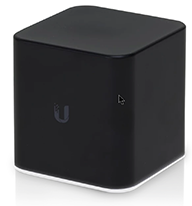
Our first recommendation is to get an additional standard airCube router and set it in bridge mode. This would be in addition to any airCube router you already have. If you want to do this, we can provide the airCube, but a paid network person would need to program it correctly to match your circumstances. We can put you in touch with the right people.
And again, just to be clear, this is for an additional airCube for use as a WiFi access point. Not your main airCube that is acting as the router and connecting you to LCWA internet. That main airCube should not be set to bridge mode.
Recommendation #2: TP-Link Wireless N Access Point,

TP-Link Wireless N Access Point, about $25
Our second recommendation for a wired extension is to get the TP-Link Wireless N Access Point shown above. The advantage to this is it is less expensive than the airCube solution, but you won’t get the diagnostics the airCube can give you. It’s a good brand, and costs only about $25 at Amazon. We’ve tested this model and it provides speeds similar to your router’s Wi-Fi speeds. It is truly plug and play, no configuration needed.
Non-Ethernet Solution:
Both above solutions require you stringing an Ethernet wire on the floor across the house to work with the wired AP locations. But as I mentioned above, there is a solution that avoids stringing Ethernet: Get a pair of powerline Ethernet adapters. These use your electrical wiring to transmit the signal, and you simply plug your short Ethernet patch cables into them at each end. We have not tested these yet, and reviews indicate they don’t always work; but some are reviewed well and the TP-Link AV1000 is a $40 pair (at Amazon) that we recommend.
And if you have an old house with coax cables in the wall, you can use an Ethernet to Coax converter to avoid stringing wires. Here’s one: https://www.amazon.com/TRENDnet-Ethernet-TMO-311C2K-Compatible-Throughput/dp/B08PDMP79D/
Much Better are Mesh and Campus Systems: the $130 to $500 Solutions
Mesh and Campus systems use high-tech approaches to spread your Wi-Fi signal. Mesh systems have become all the rage these days to cover large houses, but they are not a slam-dunk.
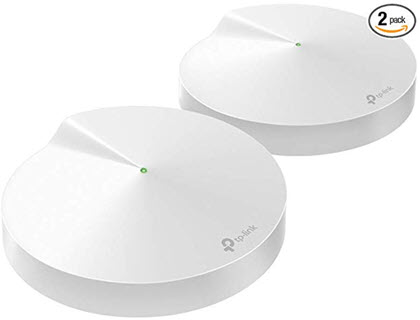
TP-Link Deco M5 Whole Home Mesh Wi-Fi starting at about $130
Pros:
- The advantage of mesh and campus systems is that they provide you one network name (called the SSID) throughout your house. That means you don’t need to manually switch your cell phone or laptop to the closer Wi-Fi point.
- Rather, your mobile device is automatically switched to the strongest source as you move around your home; this happens behind the scenes.
- They typically deliver your Wi-Fi at the full speed of your source router Wi-Fi.
- You can have as many Wi-Fi points as you want, even in different buildings.
Cons:
- Accomplishing this feat takes some fancy electronics, and so mesh and campus systems are more expensive, starting at about $130 and ranging up to $500.
- Also, pay attention when buying because if you get the wrong model it will interfere with your rooftop radio and slow everything down; so follow our recommendations ahead.
- They are harder to configure: all the solutions ahead need a little or a lot of technical configuration to set up, so keep that in mind; you might need a paid contractor to help to set them up. If so, we recommend a contractor who understand the LCWA network well.
Definitions: Mesh vs. Campus
For the purposes of this writeup, here are a few somewhat inaccurate, but helpful, definitions:
- Mesh Wi-Fi solutions typically use built-in wireless radios to connect the Wi-Fi points together. That means no extra wiring needed.
- Campus solutions in contrast typically use Ethernet wires to connect the Wi-Fi points together (but they might include mesh components as well) and typically cover larger areas
- Either mesh or wired can work well. Mesh are usually simpler to install, but some people feel wired systems are more reliable and faster.
Let’s start at the lower price point and work up.
Two-Point Campus or Mesh Systems: $130 to $160
Most moderately large houses can reach full coverage if you have two strong Wi-Fi access points strategically located in the house. Recently, several good two-point mesh and campus systems have been released that have much better price points than the original systems, starting at $130.
Start with an airCube Router. By the way, you’ll see all of the systems below start with an airCube router. This is our new standard in LCWA because it is fast, affordable, and enables our technicians to do remote diagnostics if your internet goes down. Result? In most cases you won’t have to wait for a volunteer to become available to fix things with an airCube in place. So we always start with that as the core of a solution.
The First Recommended 2-point System: TP-Link Deco M5 Whole Home Mesh Wi-Fi System $130
If you have one of our $30 airCube routers, for another $130 (current Amazon price at time of writing) you can add a good two-point mesh Wi-Fi system called the TP-Link Deco M5. We’ve been happy with the TP-Link product line because it offers a lot of high-quality value for a relatively low price, and this kit does just that. By the way, there are a few versions of this system; make sure you get the M5 version as it has some features you will need for the LCWA network.

TP-Link Deco M5 Whole Home Mesh Wi-Fi, starting at $130
Pros:
- The 2-point system covers the average size large home, up to 3800 square feet.
- For $50 more, you can instead get a 3-point package that covers up to a 5500 square feet at about $180 (at Amazon).
- Very good price compared to other mesh systems.
- Easy to configure using an app on your smartphone (we have video instructions on how to set this system up at this link).
- Very easy to turn off the 5 Ghz radio on this model (be sure to get the M5 model) to eliminate interference without fine-tuning Wi-Fi channels.
- Speeds are good for the LCWA network.
- Over 100 client devices can be connected; capable of up to 10 access points.
- Can be installed as wired system or as a wireless mesh.
Cons:
- Yes, you still must turn off the 5 Ghz radio to eliminate interference, requires a few steps (but not hard).
- Cannot fine-tune radio channels
- Using in wired mode is harder to configure.
I personally have this in my home, found it very easy to set up, and found it works very well.
Again, this is the TP-Link Deco M5 Whole Home Mesh Wi-Fi System $130 for two (current Amazon price) or for three about $180 (at Amazon).
The Second Recommended System: Adding two Ubiquiti AP-AC Lite Access Points to an airCube Router: $160.
If you have one of our $30 airCube routers, for another $160 you can create a two-point mesh or campus system that is adequate for most large houses and that can scale to an unlimited size. You do that by simply adding two Ubiquiti AP-AC Lite Access Points (about $80 each at Amazon) to that router. These access points can either be hardwired or meshed together. Note, this is not a boxed system, rather you put it together.
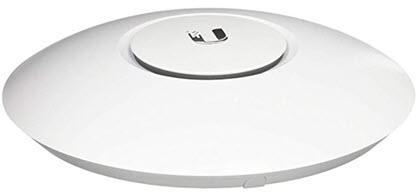
Ubiquiti AP-AC Lite Access Point, $160 for two
Pros:
- A professional-level system with a large number of configuration and monitoring choices.
- The main reason to consider this: as you expand the area you want to cover, the components and configuration tools scale well for very large campuses (with additional components and cost).
- You can configure the components either wired or mesh.
- You can add outdoor access points that cover your campus grounds using the same network name (the same SSID).
- Reasonable pricing at the starter level.
Cons:
- Not a boxed set, you build the system.
- You must fine tune the 5Ghz channel setting to avoid interference with rooftop radio.
- The main issue is this can be challenging to initially set up, requiring a pretty-steep learning curve.
I personally used this in my home for a while, and I used it in both wired and mesh format, and both work very well. But I can confirm configuration is not easy. If you do not enjoy technical challenges, then seek paid help with designing and installing this system.
Building a Larger System $180 to $500
If you have an extremely large house, or if you have multiple buildings at your home location, you’ll need to step up your game beyond a 2-point system.
One way to do that is to simply add a larger number of additional access points to any of the systems recommended above. Note that the TP-Link solution above comes in a 3-point system option for only $50 more ($180 total at Amazon), but you should buy that up front as a set; the cost of adding individual units later is much higher.
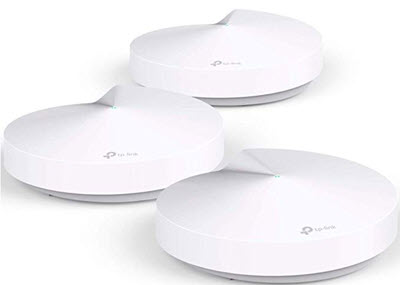
TP-Link Deco M5 Whole Home Mesh Wi-Fi, 3-pack starting at $180
And for $80 for each added point, you can expand the Ubiquity AP-AC system as much as you want. The controller software is well-suited for large installs.
Campus Systems
But that said, for separated buildings, you might need to run Ethernet wires outdoors—that’s what really defines a campus system—and that can be challenging. And if your buildings are very far apart (quarter mile or more), a long-distance radio-link or fiber optic solution might work better and that is not simple to install. Also, optimizing the configuration of the components over such distances can be difficult. We have an article about options here.
You will probably need a professional Wi-Fi contractor to help design and install a true campus system, and we can recommend a contractors for you.
Consider Multiple LCWA Accounts for High-Consumption Households
If your “campus” is widely spread with buildings far apart, you might consider having multiple LCWA accounts and radios, to make access easier.
And even if you are in one house, note this: If you have multiple TVs streaming videos simultaneously, even the best mesh or campus system can slow down when sharing one LCWA account. For example, if you share your account with renters in your attached casita, or with teenagers watching movies separately in their rooms, if they stream HD videos at the same time you do, you will see performance issues.
In this case, you should consider getting multiple LCWA accounts. You can often do that with a single roof-top radio, saving initial costs and still providing full speed on each account. Contact LCWA to discuss doing this.
Conclusion
So no, don’t buy one of those expensive, high-speed, high-power routers with big antennas and lofty claims, one’s that can cost over $200 and look impressive. You’ll be wasting your money and possibly causing problems.
Rather, start with our standard airCube router. And then if needed for a larger house, add some expansion capability like those discussed above. You’ll save money and get better results.

Comments (4)
AMPLIFI is the system I use. Strong. Dependable.
Yes, we tested an Amplifi Instant. And studied the other Amplifi models. You are right, strong and dependable. Unfortunately Amplifi, even though a Ubiquiti product line, is oddly not UNMS compliant. So to reach the LCWA UNMS support/tie-in goals we’d have to spec putting an airCube in front of it, and then the cost gets up there a bit. Also, users have to be careful and tune the 5Ghz radios away from the rooftop radio frequency, so not an easy self-configuration for 95% of our users. But yes, an excellent product.
Ok
Ok I use the AMPLIFI system.